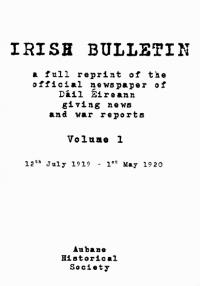Irish Bulletin a full reprint of the official newspaper of Dáil Éireann, giving news and war reports—Volume I 12th July 1919 to 1st May 1920
Published in 20th-century / Contemporary History, General, Issue 2 (March/April 2013), Reviews, Revolutionary Period 1912-23, Volume 21
Irish Bulletin: a full reprint of the official newspaper of Dáil Éireann, giving news and war reports—Volume I: 12th July 1919 to 1st May 1920
Brendan Clifford and Jack Lane (eds)
(Aubane Historical Society, €36pb/€56hb)
ISBN 9781903497746/9781903497753
The Irish Bulletin was a fact-sheet published by the Dáil government between 1919 and 1921 and circulated to opinion-formers outside Ireland to publicise repressive actions of Crown forces directed by the Dublin Castle administration. It is generally acknowledged as a very professional production which greatly assisted the Dáil government’s cause.
The Bulletin is unquestionably a valuable historical source, and the reproduction (p. xxvii) of the first page of the original (clandestinely typed and reproduced on a stencilling machine) shows how indistinct it can be. The proposed multi-volume reprint will be useful for local and national historians; the transcription is generally of high quality (though some surnames, such as ‘Porsunan’ [p. 28], look suspicious) and only occasionally are there gaps marked ‘words illegible’. It might have been better to place the editorial notes (signed ‘JL’) in footnotes or bold face rather than in brackets within the text.
The introduction by Brendan Clifford combines thumbnail sketches of individuals who worked on the Bulletin with a brief recapitulation of some historical opinions that characterise the Aubane Historical Society and related groups. These include the following points.
(a) The War of Independence was entirely a politically motivated conflict between states, with the Dáil government legitimised by the 1918 election as sole representative of the Irish people. Any use of social history techniques to discuss why some fought and others did not, why fighting broke out in one place and not another, analysis of nationalism or unionism as coalitions of diverse groups rather than state-driven monoliths, wilfully distracts attention from the central political issue—democracy versus imperialism. (In addition, Clifford alludes to his view, argued at greater length elsewhere, that Britain has historically been a purely destructive force and the First World War was entirely caused by a deliberate British conspiracy to destroy its socially progressive German rival, a view held at the time by Arthur Griffith and many Germans.)
(b) The Irish Bulletin should be read as the simple, plain truth; any attempt to assess it as shaped to influence its intended audience of British liberals—for example, the 1919 issues, instead of defending IRA actions as legitimate warfare in defence of the Dáil government, repeatedly suggest that attacks on Crown forces are staged by agents provocateurs to justify repression—is a continuation of British propaganda. (Peter Hart is described as presenting the War of Independence as ‘a serial murder campaign directed against Protestants’ which ‘verged on genocide’. This will be news to anyone who has read his books in full, as distinct from Aubane’s favourite extracts. Hart is ridiculed for suggesting that the rural IRA were made up of ‘Wrenboys and Strawboys’, whereas he argues that both reflected a wider rural youth culture; Antoinette Quinn’s biography of Patrick Kavanagh resembles Hart in her account of the young poet’s involvement with the IRA in defiance of his Redmondite father.)
(c) Academic historians of Ireland are engaged in a neo-colonial conspiracy to delegitimise the War of Independence and the nationalist project as a whole, dating back to the outbreak of the Northern Ireland conflict in 1969–70. (In fact, criticisms of post-1916 republicanism, and the general academic bias against physical-force nationalism as a historical phenomenon, date back to post-1916 Redmondite polemics and pro-Treatyite realisation during the Civil War that republican rhetoric used against Dublin Castle and parliamentarianism could be deployed against the new state. Clifford downplays this because he sees de Valera’s Fianna Fáil as the sole legitimate heirs of the nationalist tradition and denies that Redmondism and pro-Treatyism were anything more than incoherent and opportunistic responses to British power.) It is even insinuated, as in other Aubane publications, that some Irish historians are conscious ‘operatives’ for British Intelligence. Clifford assumes that academic historians all work in tandem, so that when Leonard Piper (not an academic) included an ignorant and inaccurate description of the Irish Bulletin in his biography of Childers, he is assumed to have known that all other historians would cover up for him.
Clifford assumes that academic historians are omniscient beings who already know everything there is to be known about the historical record and possess unlimited resources enabling them to write it up as they please; hence if (for example) the Dictionary of Irish Biography does not include an entry on Kathleen Napoli McKenna (an unfortunate omission), this was not inadvertence or misjudgement but a deliberate attempt to write her out of history. Clifford should acknowledge that sometimes mistakes are just mistakes. For example, when he states that Laurence Ginnell (a former Home Rule MP involved in compiling the Bulletin) was ‘the only Irish MP to support women’s suffrage’ (p. xxv), even though William O’Brien (on whom Clifford has written in the past) and two associates voted for suffrage in the very same division, this may be ascribed to carelessness, not conspiracy. Again, on p. 127 Jack Lane identifies ‘Alderman T. Kelly, MP for St Stephen’s Green’, as Seán T. O’Kelly (Seán T. was MP/TD for College Green and Alderman Tom Kelly MP/TD for St Stephen’s Green)—a different individual. This error, however, is not due to malice, but simple ignorance curable by consulting the Dictionary of Irish Biography.
Despite these concerns, the Irish Bulletin remains a telling catalogue of great and petty acts of state terror and of the contrast between the professed constitutional principles of the British government and the behaviour of Crown forces in Ireland; the Aubane Historical Society have done a service by making it more widely available. HI
















